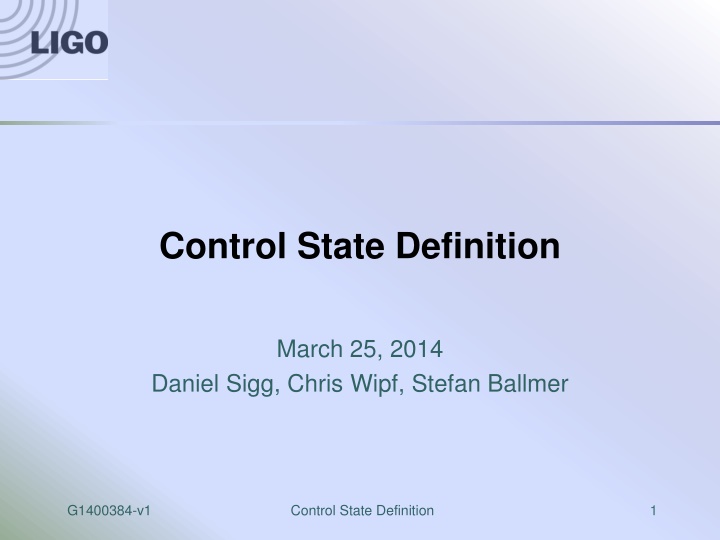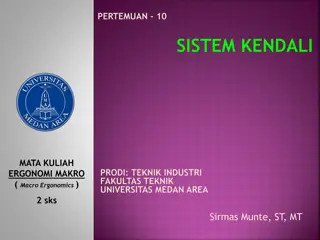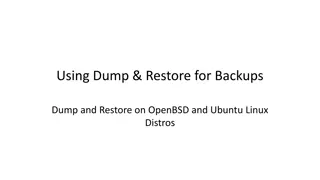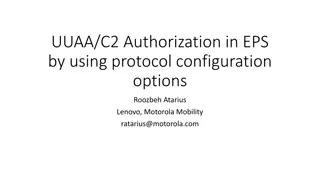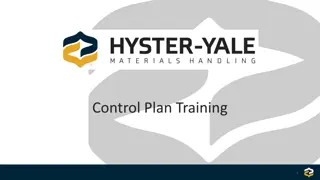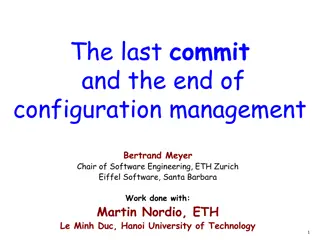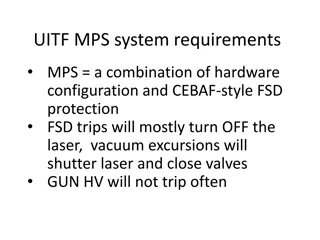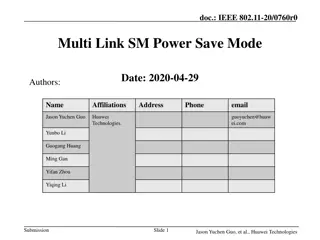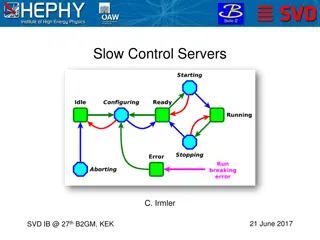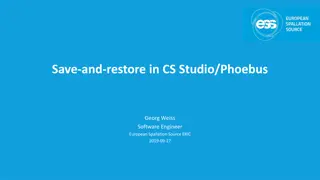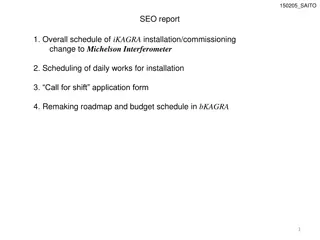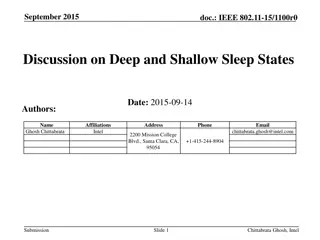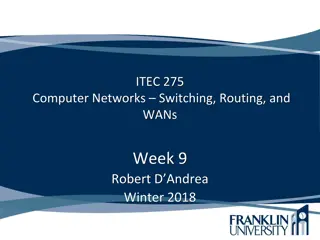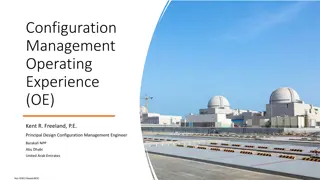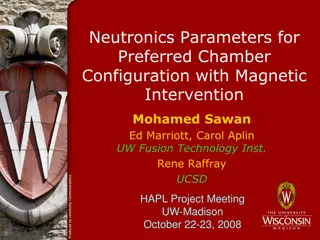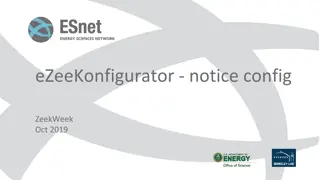Optimizing Control State Definitions and Save/Restore Processes for System Configuration Management
Addressing challenges with traditional save/restore methods, this document proposes a new approach focusing on filter files and a revamped save/restore strategy. Emphasizing the importance of scalable configurations, the text introduces a tailored approach for managing slow controls channels efficiently while highlighting the significance of good bookkeeping and user engagement.
Download Presentation

Please find below an Image/Link to download the presentation.
The content on the website is provided AS IS for your information and personal use only. It may not be sold, licensed, or shared on other websites without obtaining consent from the author.If you encounter any issues during the download, it is possible that the publisher has removed the file from their server.
You are allowed to download the files provided on this website for personal or commercial use, subject to the condition that they are used lawfully. All files are the property of their respective owners.
The content on the website is provided AS IS for your information and personal use only. It may not be sold, licensed, or shared on other websites without obtaining consent from the author.
E N D
Presentation Transcript
Control State Definition March 25, 2014 Daniel Sigg, Chris Wipf, Stefan Ballmer G1400384-v1 Control State Definition 1
Save/Restore Relying on save/restore yields inconsistent results Problem 1: Everyone needs to keep up the snap file Problem 2: What to restore to? Restore to a good configuration is a recipe for disaster Problem 3: Restore sometimes skips channels Problem 4: Anyone can make a change without save/restore Problem 5: No good way to tell how actual differs from snap Problem 6: No easy way to make an incremental change Problem 7: It scales badly Problem 8: No easy way to keep subsystems in sync (EX vs. EY) Problem 9: No good way to keep multiple configurations for the same system (e.g. LSC for PRX vs. PRY vs. PRMI, or ASC for PRMI vs. FL) Relies on everyone doing the right thing all the time Broken work flow! G1400384-v1 Control State Definition 2
Filter files This is a work flow which functions well Reason 1: All changes are going through a configuration file Reason 2: This is the only way to make a change Reason 3: There is a GUI to make the changes Reason 4: Changes are done incrementally Reason 5: You always know what s running Reason 6: We have a record of old filter files The only way to fix a problem is to actually fix it G1400384-v1 Control State Definition 3
New Approach to Save/Restore Divide slow controls channels into 4 groups 1. Readbacks (ignore for now) 2. Most of our controls never change 3. Some change states in a trivial matter E.g., boost on when lock bit is set, input matrix for PRX, PRY etc. 4. Some need to change all the time Control State Definition is meant for 2 & 3 (some) Group 4 requires code, i.e., guardian CSDef tries to mimic the work flow for filter files G1400384-v1 Control State Definition 4
Scaling is Important Slow channels: ~300,000 slow channels per ifo ~100,000 can be set ~20,000 do change Maybe 10,000 left once you have lookup tables Good bookkeeping matters! Configuration needs to be duplicated between identical sub-systems GUI tool is vitally important to get operators involved Commissioning team cannot handle ~100,000 variables G1400384-v1 Control State Definition 5
Control State Definition Configuration file: All slow controls channels must be listed Even, if they are under outside control All unlisted channels are held at zero constant Most channels will be set to a constant value (as opposite to manual) Includes safe and default values Includes lookup tables Most lookup table will have 2 states: Off and Init Replacement rules for channel names Conditions and Includes for site/location specific configurations XML GUI editors are available (schema available) Validating parser exists (C++ code) G1400384-v1 Control State Definition 6
Control State Definition (2) State machine Usual: Init, PreOp, SafeOp and Op modes Will set all values to safe in SafeOp Will set all values to their default when switching to Op Will set values to their configuration when in Op Loads a new configuration file upon request Implemented as a guardian script or as part of the EPICS ioc Will initialize all values upon a restart Checks constantly while in Op mode A value cannot be changed, if it is set constant All changes need to go through configuration file Of course, many channels will just be set to manual mode SM watches configuration file and indicates, if it has changed G1400384-v1 Control State Definition 7
How to support commissioning Changing the configuration file is as easy as changing a filter Lookup tables have an Off state Section a large front-end model into different domains Allows to talk in states rather than values, e.g., run/acquisition Allows to gang filter banks Allows for fine grade control The state machine can be set into PreOp (no writes) Less time wasted to find out has this changed? Broader user base for keeping up the configuration G1400384-v1 Control State Definition 8
Why not Hardcode it all in the front-end ECR to change values? Front-end models become very cluttered Write an incredibly large guardian script How can you tell what s going on w/o reverse engineering the code? How can you tell that you didn t forget a channel? Use hash values in the front end How do you tell what s wrong? Use the EPICS access controls This is not a security issue! Resurrect the iLIGO Stat system Creates too many secondary channels, CALC records too limited Just stay with safe/restore and snap files Proven to be problematic G1400384-v1 Control State Definition 9
Next on the list Alarm and error handling Problem 1: Alarms are global, should be reserved for real problems Problem 2: No clear text messages, why does the IMC not lock? Problem 3: Serious problems go unnoticed Problem 4: Rediscovering the same issues again and again is a major source of wasted time Solution with better track record: Condition code pioneered for the squeezer/OAT auto-lockers Hierarchical error structures (error bit, multi-bit code and msg) Each guardian/auto-locker/etc. has a set of conditions which need to be fulfilled to proceed (can be bypassed) Clear text messages of what s wrong Required additional sensors in OAT! G1400384-v1 Control State Definition 10
